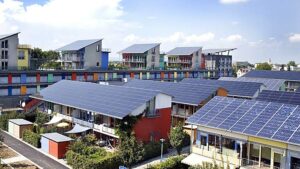Going green is a buzzword that everyone is seemingly using. But what does going green mean for homeowners? In addition to clarifying the concept, we’re going to look at the specifics in this post.

What Does Going Green Mean for Homeowners?
Looking at it from a high level, “going green” as it relates to homeownership, means reducing the consumption of energy and natural resources while increasing your efficiency and using a higher percentage of products from the higher tiers of sustainability.
That’s a lot of big words, so let’s break down what it means for your home and how you can start doing it today.
Minimizing Carbon Footprints for Sustainable Living
For homeowners interested in making their living spaces more eco-friendly, going green is an excellent way to reduce carbon footprints. Across the country, home builders are including new green technologies in their product lines. There are Louisville green builders as well. But there are also home improvements that can be made that will also improve things in this area.
As you think about the concepts, here are some specific conservation tips listed below.
Understand Your Carbon Footprint
For homeowners, going green is about understanding their carbon footprint. This means understanding their home’s energy use and how it impacts the environment. Taking small steps can go a long way, especially when accompanied by changing everyday habits.
Homeowners should take the opportunity to turn their everyday activities green. This could include walking instead of driving or line-drying clothes instead of using a dryer. Going green isn’t just about the environment; it’s also about reducing energy bills and living frugally.
Invest in Renewable Energy Sources
Installing renewable energy sources like solar panels at home can reduce home energy costs significantly. This will pay for itself in the long run. Solar panels require little maintenance, and the energy generated from these panels is renewable, clean, and unlimited.
Reduce, Reuse, and Recycle
Going green also means making a conscious effort to reduce waste. This includes simple steps such as utilizing reusable shopping bags, composting food waste, and making use of natural light whenever possible. All of these efforts contribute to a healthier and more sustainable environment.
Reusing items such as furniture and appliances are also part of a green lifestyle. Additionally, recycle as much as possible. Taking green steps can also involve composting food waste.
This includes creating nutrient-rich soil, using eco-friendly cleaning products, and performing energy audits to find out how much energy (gas, electricity, etc.) is being used in the home. Going green can also include making smart choices when purchasing supplies, such as choosing organic.
Implement Water-Saving Reducing Strategies
Water-saving methods can be implemented in our everyday lives to consume less water and save water. Simple steps such as turning off the tap while brushing teeth, taking short showers, using a bucket when washing clothes, or using fewer clothes to wash can help reduce water consumption.
Additionally, the use of rain barrels and installing water-efficient fixtures for toilets and showers can help conserve water. Lastly, installing a smart irrigation system for gardens and lawns will avoid water wastage due to overwatering of plants. These steps can substantially reduce our water consumption and help us be water-wise.
Choose Sustainable Home Improvement Options
Sustainable home upgrades are a great way to go green while still saving money. By choosing sustainable options, such as energy-efficient appliances, you can reduce your energy costs. This conserves energy while still receiving the same great quality appliances.
Installing energy efficient lighting is a great way to reduce both energy costs and environmental impacts. Additionally, adding insulation to any walls can greatly reduce your home’s energy needs. Insulation prevents heat from leaving your home during the winter months, keeping your home heated without relying as heavily on your HVAC system.
Purchasing low-flow showerheads and toilets is a simple way to save water. Installing window treatments, such as blinds, can also help with energy conservation. They can reduce the amount of sunlight coming in during the summer and increase it during the winter.
Encouraging Others to Join the Green Movement
The green movement is the current effort to promote more responsible environmental stewardship. Everyone can be an encourager to join the green movement. Start with a conversation about the impact of environmental damage and how all of us can do our part to help.
Ask questions about ways to reduce your environmental footprint. Offer alternative solutions and products to replace those that are environmentally hazardous. Demonstrate how each person participating can make a difference.
Share stories of success about those who have gone green. Educate others about the economic costs and health risks associated with the degradation of our environment. Show how green initiatives can save money in the long run.
Let them know that participating in the green movement can empower them to take action. This helps play a part in creating a healthy and sustainable environment for years to come. For more of these steps, check this resource that can help create an environmental impact that will benefit the homeowner and the planet.
Knowing the Benefits of Going Green
Going green means making more environmentally conscious decisions. The benefits of reducing our environmental impact are numerous. Listed below are the benefits of taking green steps today:
Conserving Natural Resources
Conserving resources conserves wildlife and habitats, and can even reduce global warming. Going green and conserving natural resources can help our environment today and prepare us for a better tomorrow. We are the caretakers of this planet and by each of us doing our part, we can create a healthier and cleaner environment.
Energy and Financial Savings
Going green is a way to save energy and money and create a better environment. By using green energy sources, such as solar, wind, and geothermal, and switching to energy-efficient appliances, we can save money and reduce the amount of energy we consume. An energy-efficient refrigerator can cost around 25% less to run than a standard model.
For example, using solar power can help you save up to $100 on your energy bill annually. Additionally, you will also qualify for federal tax credits and other incentives that can help reduce your energy costs even more. Going green not only saves money but also helps reduce carbon emissions, which can save the environment.
What Going Green Means Today
Going green is a great way for homeowners to reduce their bills, show their respect for the environment, and promote a better way of life. It can be both easy and rewarding. This is to make your home more sustainable.
Take positive steps towards a healthier future today. Start to explore what going green means in your home. If you find this article helpful, check out more of our blog posts.



